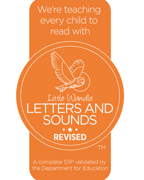- Home
- Curriculum
- English Reading
English Reading
At Bulford St Leonard's CofE Primary School, we seek to ignite a passion for reading and love of books through our reading curriculum.
Intent:
-
Promote a love of reading; through a variety of genres and authors, pupils experience a rich diet of literature.
-
Link, reading texts (where relevant,) to big questions, non-core learning to help pupils to connect their growing knowledge.
- Provide opportunities for discussion of texts and sharing a love of reading which reflects our school values of communication, determination and future dreaming.
- Ensure that explicit teaching of reading skills and strategies to support pupils in accessing all subject areas and understanding the world around them.
- Ensure that pupils are exposed to a range of texts which means they become fluent and accurate in reading across a variety of genres and styles.
- Develop a consistent approach to teaching reading in order to close gaps and ensure that all children leave in year 6 being able to read to learn.
Implementation:
We believe that the acquisition of the phonetic code, fluency and proficient comprehension as an entitlement for all children has the power to transform lives; it enables them to access the whole curriculum and engage more fully with the world around them. We ensure as many opportunities as possible during the school day to read, enjoy, share and discuss books.
Learning to read
 We follow a systematic approach to teaching phonics, using the Little Wandle Letters and Sounds Revised programme. The teaching of phonics begins in Reception, and teaching continues daily to at least the point where children can read almost all words fluently. This provides children with the skills they need to begin to read words, captions and whole sentences as soon as possible.
We follow a systematic approach to teaching phonics, using the Little Wandle Letters and Sounds Revised programme. The teaching of phonics begins in Reception, and teaching continues daily to at least the point where children can read almost all words fluently. This provides children with the skills they need to begin to read words, captions and whole sentences as soon as possible.
Focused reading practice
In Reception and Year 1, children practise reading using LW Big Cat decodable books that are closely matched to their developing phonic knowledge. Our children often reread the same text multiple times to develop their comprehension and fluency which includes their accuracy, automaticity (rapid recall of whole known words) and prosody (reading with expression).
Daily Reading practice
Pupils in all classes have opportunities to read daily; in reading groups in EYFS and KS1, or whole class reading or independent reading in KS2. Pupils also have opportunities to read in other subjects across the curriculum. Pupils who are less fluent will read regularly 1:1, with a focus on the lowest 20%.
Support to Keep up and Catch up
Until pupils are fluent readers, ‘Keep up’ sessions are used for pupils who teachers identify in on-going assessment as needing more support in consolidating their phonics knowledge. KS2 pupils who need more support in developing their reading skills receive intervention on an individual or small group basis if they need support in addition to whole class reading.
Access to appropriate books
We recognize the importance of reading at home to practice and embed reading skills. Pupils in R/Yr1 take home their Little Wandle book and a ‘snuggle’ book to enjoy with a grown up. Fluent readers in KS1, and all KS2 pupils can access the class reading corner to choose a reading book.
Support at home
Pupils all have a reading record to keep track of their reading and provide a link to school. In R/Year 1 teachers will use LW assessments to determine when pupils move onto the next level of challenge. In all years, teachers also monitor reading frequency and choices to expand their interest where needed. Children are expected to read regularly at home and in school.
Reading for meaning
Explicit teaching of reading skills and strategies
In EYFS and Yr1, pupils practice comprehension as part of the their reading practice. As soon as children master the alphabetic code and can read fluently, in Year 2, we begin to use a whole class guided reading model. Reading lessons are daily for 30 minutes.
A clear framework for reading lessons
In whole class reading lessons, pupils read from a reading spine of high-quality fiction, non-fiction and poetry, which is used to explicitly teach and consolidate the reading skills needed for pupils to be confident readers for meaning. Across a two-week cycle, pupils will use the class reader, as well as one lesson of non-fiction texts and one on a poem, to explore the range of reading domains. At the start and end of each term, a book talk session is used to share recommendations and encourage a love of reading.
Each lesson is structured to ensure pupils can access the vocabulary in the text; to focus on a specific skill or strategy which is explicitly taught and modelled, before being independently applied. The teacher models prosody and fluency, and in some lessons, pupils are given opportunities to practice reading with fluency as another tool to enhance comprehension of the text. A combination of extended and close reading ensures pupils can engage with and explore texts in a meaningful way. Pupils demonstrate their learning through a mixture of discussions, group work and written responses. Teachers assess daily through questioning and providing feedback orally, and through monitoring the quality of pupils’ responses.
Love of reading
A diet of quality texts
The choice of texts in the reading spine is intended to inspire pupils to continue reading class books, and other books by the same author. A range of books is available in class libraries for pupils.
Allocated time for independent reading
There is time dedicated in the school day for pupils to read independently; pupils can choose to read during lunchtime if they wish (and often do)
Daily story time and reading together
Story time happens in every year group, before lunchtime: to ensure the children are read to everyday and share, discuss and enjoy the endless possibilities of books. The choice of text is sometimes shared with pupils, and sometimes includes the guided reading texts.
Impact:
- By engaging with high quality texts, children read with enthusiasm and enjoy talking about their reading.
- Pupils can make links and connections between their reading and other subjects; including through their writing.
- Pupils show the school values through discussion about texts: they are confident communicators, show determination with challenging texts and have their imaginations fired up.
- Pupils can read and make sense of a variety of texts – not only evidenced in NFER assessments, but in their readiness for transitions to the next stage of their education.
- We aim for pupils to achieve the age-related expectations for reading, and those that find reading challenging are targeted for intervention to catch up and make progress.




